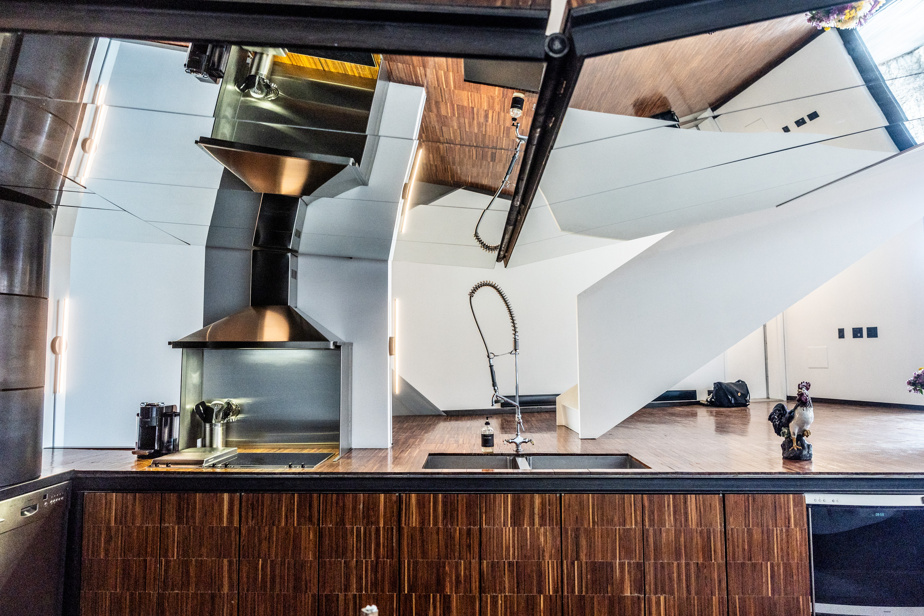Confusion follows astonishment upon entering this atypical residence, to say the least. This reaction is not of the order of delight, nor is it a negative response to what is revealed to the visitor. We would rather describe it as a loss of reference points regarding the idea we have of a habitable environment. Doubt sets in as soon as you enter: will the floor start to move without warning? This discomfort is normal and even desired, as we will learn later.
Louise Locas greets us at the door. Collaborator and associate of Claude Cormier for 17 years, she knew and frequented the depths of 1221 rue des Carrières and its adjacent units, which include the offices of the landscape architecture firm and three apartments, also for sale following the death of their owner last year.
“Be careful not to hit your head,” she warns us during the visit. “You have to watch where you step,” she says again. Sound advice. You have to be alert to visit this place where one surprise awaits another: angled walls, sloping floors, an unexpected step, hidden doors, mirrors or hidden corners. The Black Castle, as its owner called it, reveals a never-before-seen and fascinating division of space, almost labyrinthine, but it is easily tamed, assures the person who visited it.
20 years ago, rue des Carrières was still dotted with workers’ workshops. It is in this industrial district that Claude Cormier acquired a former cabinetmaking workshop in order to set up his residence and office there. To do this, he contacted Jacques Bilodeau, an artist fascinated by modular shapes and spaces, whose work he admires.
“It was the time when you could still buy at an “acceptable” price,” the latter, who then transformed industrial or abandoned buildings, will tell us. An era where we could have the luxury of exploring space in the name of art. This experimental quest will bring together the two artists, also neighborhood neighbors, who share certain artistic affinities. They express themselves in the landscape, for one, in the decor, for the other, and in artistic installations, some of which will be made jointly.
Influenced by the “oblique function”, or the conquest of the inclined plane, Bilodeau interprets the concept of the architect Claude Parent and transposes it into space. “Parent’s idea was to design spaces in which the body is stimulated, the aim being to keep it alert,” he explains. It marked all my work. »
In Claude Cormier’s house, this approach manifests itself primarily on the floor. The floor is a terrain to be surveyed and transformed according to needs or desires. Made up of platforms decorated with walnut parquetry, the floor is irregular, mobile and continues onto the surfaces of the kitchen, which is recessed into the ground.
In the original concept, you set foot on the moving platforms as soon as you enter. These can slide in to eclipse the kitchen and extend the flat surface of the floor. The loft contains no steps – only slopes – and the desire is to reduce furniture to the bare minimum. A few pieces were added over time to this “soft floor”, but the whole remained refined. Claude Cormier then “lives” his concept which is intended to be an experience in space.
A few years later, cramped in its offices now occupied to maximum capacity, the occupant is forced to reassess its situation. Between moving and renovating, he chose the second option, “too attached to this house to leave”, said Louise Locas. The sentimental aspect will therefore win out and two additional floors will be added to the building.
Mezzanines will also be added, on the house side, while the initial loft remains untouched: the first accommodates a fireplace, a corner bathroom and an aisle of wardrobes wrapped in brass. The new bedroom, cramped like the previous one, overlooks the mezzanine below and its fireplace. Jacques Bilodeau was called upon again for this metamorphosis, the angular aspect of which he explained as follows: “We kept all the available space, which created corner niches, like in the bathroom. The effect is accentuated by reflective coatings, such as mirrors. »
“This house is the meeting between two artists who had an extraordinary vision of space. I would say that they found each other,” notes Louise Locas.
Claude Cormier was a particular client who agreed to push ideas and put creation and concept over comfort, retains Jacques Bilodeau, who describes this project as being his most successful of its kind. “I have the chance to experience things in life. I work a lot with steel and raw materials. He was more refined. The wood, the mirrors, the coverings, it’s very much him. »
The landscape architect loved noble materials and was meticulous in his approach, also notes his former associate. “He left nothing to chance. He had a teasing look, a little crazy in the good sense of the word. Everything was an excuse to talk. He loved chic, luxury, extravagance, and at one point in his career he was able to afford it and wasn’t embarrassed by it. He worked hard, all the time, which was easy with his workshop nearby. » An intense being? “Absolutely,” she replies.
“He took full possession of this space,” emphasizes Jacques Bilodeau. You had to have the personality to do it. This clearly illustrates his great open-mindedness. » Since he was not the type to take pruning shears, there were no plants in his house, but at the edge of the building, an avenue of wild rose bushes – spectacular when in bloom – bears witness to this part of life exceptional.
This extraordinary heritage is now up for sale, not without a pang in the heart, admits Louise Locas. “It’s hard to imagine the customer who will be able to live there. It is certain that Claude would have wanted it to remain untouched, it was his baby, but the building has a lot of potential and what it will become is in the hands of the future owners. »
Environments are made to evolve, Jacques Bilodeau consoles himself. “This house will never be the same again because it will not be inhabited by Claude Cormier. What we do in life keeps us busy, it motivates us, but afterward, this project remains a building and it is very rare that we make mausoleums out of it. »


















